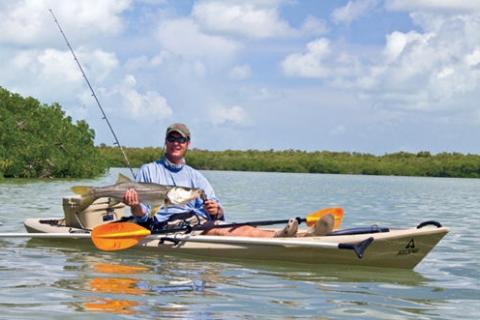
 Paddling for fish in the quiet reaches of a salt marsh has a quality that not many other experiences can equal. The only sounds are the gentle ripples of the water around the paddle as you move forward, searching for that redfish tail or oyster rake.
Paddling for fish in the quiet reaches of a salt marsh has a quality that not many other experiences can equal. The only sounds are the gentle ripples of the water around the paddle as you move forward, searching for that redfish tail or oyster rake.
Kayak Fishing
Kayak fishing has taken off in America and around the world, and kayak makers are now specializing in boats built specifically for those anglers. These boats are relatively inexpensive and can be equipped with numerous options to fit any angler's needs.
Anglers in larger fishing boats are limited to fishing areas dictated by the water depth and access. Kayakers on the other hand have an almost unlimited access to water that is pristine and relatively unfished. That means they can find and catch fish that others can't reach.
Most backwater "Yak" anglers will be putting boats in the water a couple of hours before the high tide in the area they plan to fish. That gives them about four hours of good fishing water before the outgoing tide leaves the area unnavigable. Many of the areas that anglers fish in their Yaks are almost dry at low tide. That dictates keeping track of the time and paying close attention to falling water.
Yak anglers fish the salt marshes, the backwater and the bays that can only be accessed by boats like theirs. But, they aren't limited to those kinds of waters. Yak anglers have been found in harbors, in major bays and in the surf. Some are even brave enough to venture beyond the surf, paddling several miles offshore in search of bigger fish.
![]() Tip: How to Get Your Kayak Fishing Ready
Tip: How to Get Your Kayak Fishing Ready
Kayak Fishing Gear
 |
| Kayakers have almost unlimited access to water that is pristine and relatively unfished. |
The fishing gear used by yak anglers is really no different than any other fishing gear. It is usually light tackle, and spinning outfits are most common. A few bait casting outfits will be seen, but while sitting in a kayak, it is easier to work a lure or jig with a spinning rod than a bait caster.
The fishing lures and baits used are the same varieties that are used locally by other anglers. Live bait, dead bait and artificial baits are all used by kayak fishermen. The only real difference is the vehicle from which they fish and the areas they can access.
Kayak Fishing Advantage
Many areas of coastal America are looking to protect estuaries and salt marshes by closing large portions of those estuaries and marshes to motor boat traffic. To many anglers, that means closing their fishing territory. But, the kayak offers anglers the opportunity to explore and fish these areas even though they are closed to motor boats.
With more and more emphasis on the environment and habitat restoration, kayak anglers will have a definite advantage in the future. Only those super sensitive areas that prevent any human intervention will be off limits.
![]() Tip: 7 Reasons Why You Should Go Kayak Fishing
Tip: 7 Reasons Why You Should Go Kayak Fishing
Types of Kayaks
Kayaks for fishing come in two basic designs: "sit-in" or "sit-on-top". The sit-in kayak models are just that — anglers sit inside the kayak, actually on the bottom. These boats tend to be smaller than other kayaks, and while they do have a back rest, rods holders and other amenities, they leave you down low, right on the water. Some paddlers argue that they are the most stable design.
 |
|
|
The sit-on-top kayak models allow anglers to sit higher in the craft. That gives them two advantages. First, from a safety standpoint, it gives them a quicker exit should the boat overturn. Second, it provides a higher profile that gives the angler a bit more fishing advantage. That makes it easier to cast and fight a fish. There are some sit-on-top models that allow the angler to actually stand to cast or fight a fish. These are usually double-hulled boats that offer more stability.
Testing the Waters
Whatever kayak you choose, you need to prepare for that first fishing trip. Head out with no equipment. With someone else at your side, flip the boat — yes, purposely get wet and flip the boat. Make sure you can get out of a boat that has flipped. You don't want to be on the water upside down and be unable to exit your boat. And, it's not a matter of "if" the boat flips — it's a matter of when! You would be wise to learn to flip the boat back upright with you in it! Master the Hip Snap technique, it's an essential skil for sea kayaking.
If you don't want to lose the contents of the boat — tackle box, cooler, etc. — you need to make sure everything is tied down and secure before heading out. If you take a camera, make sure it is waterproof. Once again, it's not a matter of if — it's a matter of when.
All these warnings should not scare anglers from kayaks. Actually common sense and careful preparation make this sport very safe.
- 15776 views

